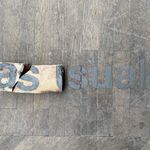ANTONIS PITTAS / one brick at a time, 2021

PRESENTING THE EKO 8 ART PROJECTS
ANTONIS PITTAS / one brick at a time, 2021
site-specific installation, MTT, Melje, mixed media, recycled bricks, graphite putty
courtesy of the artist
The work of Antonis Pittas is characterised by the historical awareness he holds whilst addressing contemporary social and political issues. Pittas often explores topics, such as safety and control, economic crises and acts of resistance, as well as ideas of iconoclasm and vandalism. For the artist, an important frame of reference is the visual language of modernism and the historical avant-gardes, including Bauhaus, De Stijl, and Russian Constructivism. Forms from this period are traced throughout history as they travel to unlikely situations, attaining new shapes and meanings. Pittas maps their transhistorical lines of development and investigates how they re-appear in the present.
one brick at a time is comprised of more than 1500 used bricks; texts and phrases rubbed in graphite are to be found. Not all the words and sentences can be read as the artist uses different scales and works with layers. Some of the texts are on the surface of the bricks and others reach out to the floor and walls of the dormant Folding House space of the MTT factory site.
Up against the ecological crisis and the language and symbols used to convey its tipping point, Pittas has researched structures of resistance as used by protestors and seen on the streets of Hong Kong – informal piles of bricks, quite literally ripped up from the Hong Kong pavements. A field of obstacles, ad hoc devices and piles of paving stones to keep security vehicles and police snatch squads from reaching the protestors. The seemingly spontaneous nature of the street arrangements is of interest, physically grown from the floor. The detritus of a street riot here is just one visual reference as well as past views of the factory with its processing machines and factory workers.
Reflecting on the title of the triennial A Letter to the Future, and the actions of many others to an ecological crisis that has difficulty being announced and difficulty being verbalised, Pittas deploys texts associated with protest, of awakened action, with observed phrases and quotations taken from newspapers. This motif of layered graphics, of performed presentation on surfaces and onto architecture, in order to activate citizenship and create these new readings, is a central aspect to Pittas' practice.
Socialist Yugoslavia and the history of the MTT in the post-war period had its own modernist visual language that the installation reflects upon. Pittas' research-based approach is informed by the idea that utopian aspirations can be easily turned into their opposite, leading to destruction, oppression, and an affirmation of power and authority. By exposing this dynamic, Pittas' work offers a space for thought and reflection, both on history and the now.
Antonis Pittas (b. 1973, Athens, Greece) lives and works in Amsterdam, the Netherlands. He studied at the Athens School of Fine Arts, the Piet Zwart Institute in Rotterdam, and the Sandberg Institute in Amsterdam. He has been an artist-in-residence at the Center for Curatorial Studies at Bard College in Annandale-on-Hudson, New York and is currently honorary fellow of the Faculty of Humanities, University of Amsterdam, where he is researching and producing work under the rubric 'Recycling History (contemporising history/historicising the contemporary)'. Pittas holds a tutor position at the Royal Academy of Art in The Hague and the Design Academy Eindhoven.





